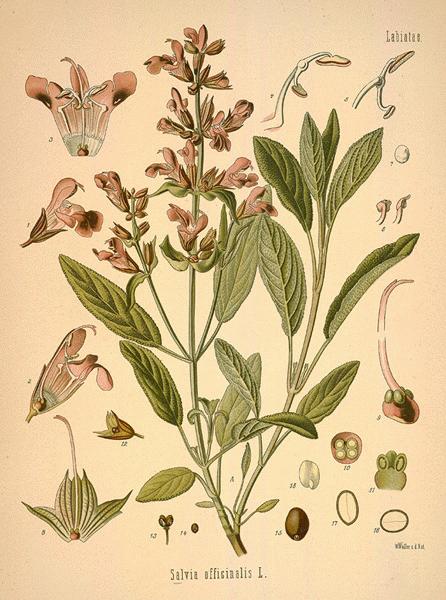 Also Known As:
Also Known As:
Common Sage, Garden Sage, Meadow Sage.
Scientific Name:
Salvia officinalis.
Family: Lamiaceae/Labiatae.
People Use This For:
Orally, sage is used for loss of appetite; excessive perspiration; painful periods; diarrhea; gastritis;reducing discharge from the breast; reduction of saliva secretion; and digestive problems including flatulence, bloating, and dyspepsia. It is also used for depression, cerebral ischemia, memory enhancement, and Alzheimer's disease.
Topically, sage is used for herpes labialis, laryngitis, pharyngitis, stomatitis, gingivitis, glossitis, minor oral injuries, and inflammation of the nasal mucosa.
In foods, it is used as a culinary spice.
In manufacturing, sage is used as a fragrance component in soaps and cosmetics.
Safety:
No concerns regarding safety when used orally in amounts commonly found in foods. Sage is approved for food use in the US.13
No concerns regarding safety when used orally in therapeutic doses, short term. Sage seems to be safe when taken orally for up to 4 months.140,141 No concerns regarding safety when used topically.142
Pregnancy and Lactation: Traditionally used to dry up breast feeding. Avoid in breast feeding mothers.
Effectiveness:
POSSIBLY EFFECTIVE
Alzheimer's disease. Taking extracts of Salvia officinalis and Salvia lavandulaefolia orally seem to improve cognitive function in patients with mild to moderate Alzheimer's disease when used for up to 4 months.140,141
Herpes labialis (cold sores). Topical treatment of herpes labialis with a cream containing sage and rhubarb (Rheum officinale and Rheum palmatum) may be about as effective as acyclovir (Zovirax) cream. Acyclovir cream provides healing of lesions in 6.3 days; the sage and rhubarb cream provides healing of lesion in 7.2 days. The combination of sage and rhubarb appears to improve the time to healing and to reduce pain, compared with sage alone.142
INSUFFICIENT RELIABLE EVIDENCE to RATE
Memory. Single doses of Salvia lavandulaefolia might enhance memory in a dose-dependent manner in young adults.143 More evidence is needed to rate sage for this use.
Mechanism of Action:
The applicable part of sage is the leaf and volatile oil.
Adverse Reactions:
Orally, sage can cause nausea, vomiting, abdominal pain, dizziness, agitation.141
Interactions with Herbs & Supplements:
None reported
Interactions with Drugs:
None reported.
Interactions with Foods:
None known.
Dosage/Administration:
Dr Clare’s Blends: 1 gm/day
Usual dose: 1-12 gms /day in divided doses.
Comments:
Sage is a rich source of beta-carotene.144
Specific References: SAGE
139. FDA. Center for Food Safety and Applied Nutrition, Office of Premarket Approval, EAFUS: A food additive database. Available at: vm.cfsan.fda.gov/~dms/eafus.html.
140. Perry NS, Bollen C, Perry EK, Ballard C. Salvia for dementia therapy: review of pharmacological activity and pilot tolerability clinical trial. Pharmacol Biochem Behav 2003;75:651-9.
141. Akhondzadeh S, Noroozian M, Mohammadi M, et al. Salvia officinalis extract in the treatment of patients with mild to moderate Alzheimer's disease: a double blind, randomized and placebo-controlled trial. J Clin Pharm Ther 2003;28:47-9.
142. Saller R, Buechi S, Meyrat R, Schmidhauser C. Combined herbal preparation for topical treatment of Herpes labialis. Forsch Komplementarmed Klass Naturheilkd 2001;8:373-82.
143. Tildesley NT, Kennedy DO, Perry EK, et al. Salvia lavandulaefolia (Spanish Sage) enhances memory in healthy young volunteers. Pharmacol Biochem Behav 2003;75:669-74.
144. Brinker F. Herb Contraindications and Drug Interactions. 2nd ed. Sandy, OR: Eclectic Medical Publications, 1998.